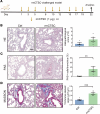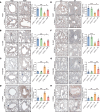Increased expression of cathepsin C in airway epithelia exacerbates airway remodeling in asthma
- PMID: 39436705
- PMCID: PMC11601913
- DOI: 10.1172/jci.insight.181219
Increased expression of cathepsin C in airway epithelia exacerbates airway remodeling in asthma
Abstract
Airway remodeling is a critical factor determining the pathogenesis and treatment sensitivity of severe asthma (SA) or uncontrolled asthma (UA). The activation of epithelial-mesenchymal trophic units (EMTUs) regulated by airway epithelial cells (AECs) has been proven to induce airway remodeling directly. However, the triggers for EMTU activation and the underlying mechanism of airway remodeling are not fully elucidated. Here, we screened the differentially expressed gene cathepsin C (CTSC; also known as dipeptidyl peptidase 1 [DPP-1]) in epithelia of patients with SA and UA using RNA-sequencing data and further verified the increased expression of CTSC in induced sputum of patients with asthma, which was positively correlated with severity and airway remodeling. Moreover, direct instillation of exogenous CTSC induced airway remodeling. Genetic inhibition of CTSC suppressed EMTU activation and airway remodeling in two asthma models with airway remodeling. Mechanistically, increased secretion of CTSC from AECs induced EMTU activation through the p38-mediated pathway, further inducing airway remodeling. Meanwhile, inhibition of CTSC also reduced the infiltration of inflammatory cells and the production of inflammatory factors in the lungs of asthmatic mice. Consequently, targeting CTSC with compound AZD7986 protected against airway inflammation, EMTU activation, and remodeling in the asthma model. Based on the dual effects of CTSC on airway inflammation and remodeling, CTSC is a potential biomarker and therapeutic target for SA or UA.
Keywords: Asthma; Pulmonology; Respiration; Therapeutics.
Figures








Similar articles
-
Airway epithelial overexpressed cathepsin K induces airway remodelling through epithelial-mesenchymal trophic unit activation in asthma.Br J Pharmacol. 2024 Oct;181(19):3700-3716. doi: 10.1111/bph.16423. Epub 2024 Jun 9. Br J Pharmacol. 2024. PMID: 38853468
-
Airway epithelial ITGB4 deficiency induces airway remodeling in a mouse model.J Allergy Clin Immunol. 2023 Feb;151(2):431-446.e16. doi: 10.1016/j.jaci.2022.09.032. Epub 2022 Oct 13. J Allergy Clin Immunol. 2023. PMID: 36243221
-
Protein tyrosine phosphatase SHP2 regulates TGF-β1 production in airway epithelia and asthmatic airway remodeling in mice.Allergy. 2012 Dec;67(12):1547-56. doi: 10.1111/all.12048. Epub 2012 Oct 11. Allergy. 2012. PMID: 23057634 Free PMC article.
-
What Have In Vitro Co-Culture Models Taught Us about the Contribution of Epithelial-Mesenchymal Interactions to Airway Inflammation and Remodeling in Asthma?Cells. 2020 Jul 15;9(7):1694. doi: 10.3390/cells9071694. Cells. 2020. PMID: 32679790 Free PMC article. Review.
-
Putting the Squeeze on Airway Epithelia.Physiology (Bethesda). 2015 Jul;30(4):293-303. doi: 10.1152/physiol.00004.2015. Physiology (Bethesda). 2015. PMID: 26136543 Free PMC article. Review.
Cited by
-
Causal association between circulating cytokine levels and the risk for asthma: A bidirectional, Mendelian randomization study.Medicine (Baltimore). 2025 Jul 18;104(29):e43364. doi: 10.1097/MD.0000000000043364. Medicine (Baltimore). 2025. PMID: 40696647 Free PMC article.

